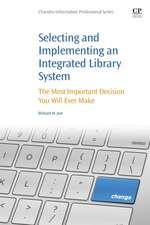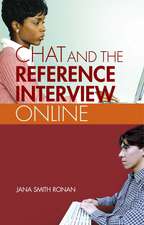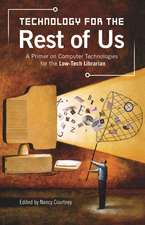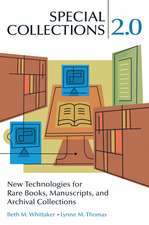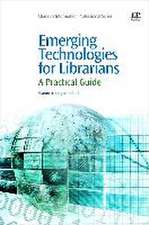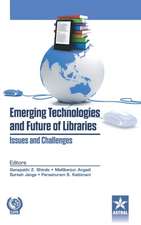Strategies for Building a Web 2.0 Learning Environment
Autor Chih-Hsiun Tuen Limba Engleză Paperback – 19 noi 2013 – vârsta până la 17 ani
Preț: 297.31 lei
Preț vechi: 413.64 lei
-28% Nou
Puncte Express: 446
Preț estimativ în valută:
56.90€ • 58.90$ • 48.09£
56.90€ • 58.90$ • 48.09£
Carte tipărită la comandă
Livrare economică 05-19 martie
Preluare comenzi: 021 569.72.76
Specificații
ISBN-13: 9781598846867
ISBN-10: 1598846868
Pagini: 192
Dimensiuni: 156 x 235 x 13 mm
Greutate: 0.32 kg
Editura: Bloomsbury Publishing
Colecția Libraries Unlimited
Locul publicării:New York, United States
ISBN-10: 1598846868
Pagini: 192
Dimensiuni: 156 x 235 x 13 mm
Greutate: 0.32 kg
Editura: Bloomsbury Publishing
Colecția Libraries Unlimited
Locul publicării:New York, United States
Caracteristici
Supplies practical guidelines, learning activities, interactive links and templates, and reader-shared resources useful for educators, trainers, and instructional designers
Notă biografică
Chih-Hsiung Tu, PhD, is professor of educational technology at Northern Arizona University, Flagstaff, AZ.
Cuprins
IllustrationsPrefacePart I Background and ConceptsChapter 1 IntroductionWeb 2.0 Disrupts LMSParadigm ChangeIssuesWhy This Book?For EducatorsFor Professional ReferencesFor ResearchersWhat Will You Learn from This Book?How to Use This BookBackgroundChapter 2 Concepts of PLE and ONLEEmerging Learning ConceptPersonal Learning EnvironmentOpen Network Learning EnvironmentFramework and ConstructsOpen Network Linkage Design ModePersonal Portal LinkageWidget LinkageRSS LinkageThird-Party LinkageSocial Tagging LinkageSocial Network LinkageMobile LinkageInfoViz LinkagePart II Social DimensionChapter 3 Devise Digital IdentityDigital Identity Design ConceptsDigital Identity Development GuidelinesTo Select Digital IdentitiesTo Organize Digital IdentityTo Share and Collaborate on Digital IdentityTo Link Tools to Digital IdentityDigital Identity DesignsTo Create Digital Identity ActivitiesLinkage Designs for Digital IdentityLearning Activity: Presenting Appropriate and Professional Digital IdentitiesCase I: Crafting Digital Personal Profiles Like CelebritiesCase II: Professional Personal Digital Social IdentitiesLast WordsKey Linking ThinkingChapter 4 Learn to Be a Butterfly on Social NetworksSocial Network Design ConceptsSocial Network Design GuidelinesTo Select the Tools with Social Network FeaturesTo Organize a Social NetworkTo Share and Collaborate on Social NetworksTo Link Tools to Social NetworkSocial Network DesignsTo Create SNL ActivitiesSocial Network Linkage DesignsLearning Activity: Social Content Sharing and CollaborationCase I: Instructional Announcements on TwitterCase II: Social Annotation Sharing and Collaboration on Diigo GroupLast WordsKey Linking ThinkingPart III Network DimensionChapter 5 Accrue RSS LinkageRSS Design ConceptsRSS Design GuidelinesTo Select Network Resources with RSS FeedsTo Organize RSS FeedsTo Share RSS Feeds and Collaborate with OthersTo Link Tools to RSSRSS Activity DesignsTo Create RSS ActivitiesLinkage Designs for RSSLearning Activity: Multiple RSS Linkage Design for Instruction TimelineChapter 6 Believe in the Wonder of WidgetsWidget Linkage Design ConceptsWidget Linkage Design GuidelinesTo Select Tools and WidgetsTo Organize WidgetsTo Share and Collaborate on WidgetsTo Link Tools to WidgetsWidget Linkage Activity DesignsTo Create Widget ActivitiesWidget Linkage DesignsLearning Activity: Aggregate Learning ContentCase I: Aggregate Course Learning Instructions for TeachersCase II: Learner-Generated eTextbooksLast WordsKey Linking ThinkingChapter 7 Discover the Hidden Power of Third-Party LinkageThird-Party Linkage Design ConceptsThird-Party Linkage Design GuidelinesTo Select Network Resources to Be LinkedTo Organize Third-Party LinkageTo Share and Collaborate on Third-Party LinkageTo Link Tools to Third-Party LinkageThird-Party Linkage Activity DesignsTo Create Third-Party ActivitiesThird-Party Linkage DesignsLearning Activity: Streamline Resource SharingCase I: Streamline Resources Posting and SharingCase II: Sync Multiple CalendarsLast WordsKey Linking ThinkingPart IV Integration DimensionChapter 8 Construct Your PLEPLE Design ConceptsPLE Design GuidelinesTo Select Network Portal ToolsTo Organize Gadgets on PLETo Share and Collaborate on PLETo Link Tools to PLEPLE Activity DesignsTo Create iGoogle ActivitiesLinkage Designs for PLELearning Activity: Create PLE on iGoogleLast WordsChapter 9 Mobilize Your LearningMobile Linkage Design ConceptsMobile Apps Design GuidelinesTo Select Mobile AppsTo Organize Mobile AppsShare and Collaborate with Mobile AppsTo Link Tools Mobile LinkageMobile Linkage Activity DesignsTo Create Mobile Apps ActivitiesMobile Linkage DesignsLearning Activity: Exploring and Collaborating with Mobile AppsCase I: Mobile Social Networking for Museum Scavenger HuntCase II: Analyze and Share Mobile AppsLast WordsKey Linking ThinkingPart V Cognitive DimensionChapter 10 Make Your World FlatFlat-Structured Discussion Design ConceptsLearning ImpactsWeaving and Synthesizing PostingsAuthentic Learner-Centered LearningFlat-Structured Discussion Design GuidelinesTo Select a Features-Rich Discussion BoardTo Organize Flat-Structured DiscussionsTo Share and Collaborate within Flat-Structured DiscussionsTo Link Tools to a Flat-Structured Discussion BoardFlat-Structured Discussion Activity DesignsLinkage Designs for Flat-Structured DiscussionLearning Activity: Open Network Discussion Board: Engaging without VisitingSetting Up Your Nabble Discussion BoardRecommended Linkage Design IntegrationsReviewing and Participating in a Discussion Board via E-mailReviewing and Participating via RSS Feed SubscriptionUsing a Personal Portal to Manage the DiscussionsApplying the Timeline Format to Understand Discussion ActivitiesEmploying Word Clouds to Examine the Discussion PostingsLast WordsKey Linking ThinkingChapter 11 Tag to Touch Your CommunitySocial Tagging Linkage Design ConceptsSocial Tagging Design GuidelinesTo Select Social Tagging ToolsTo Organize Social Tagging ArchitectureTo Share and Collaborate on Social Tagging ArchitectureSocial Tagging Linkage Activity DesignsTo Create Social Tagging ActivitiesSocial Tagging Linkage DesignsLearning Activity: Social Tagging to Support Network Learning CommunityDefine Course Social Tagging ArchitecturesOrganized Assigned ReadingsEmbedded in Existing Course ActivitiesBuild Collaborative Groups and CommunitiesOrganize Online Discussion PostingsConduct Tag SearchLast WordsChapter 12 Erase the InvisibilityInfoViz Linkage Design ConceptsInfoViz Design GuidelinesTo Select InfoViz Linkage Tools and DataTo Organize InfoViz LinkageTo Share and Collaborate via InfoViz LinkageTo Link Tools to InfoViz LinkageInfoViz Linkage Activity DesignsTo Create InfoViz ActivitiesInfoViz Linkage DesignsLearning Activity: Apply InfoViz to Enhance Online DiscussionsCase I: Integrating Words and Tag Clouds to Enhance Online DiscussionsCase II: Visualizing Course ActivitiesCase III: Integrating Word Clouds to Improve Writing AssignmentsLast WordsChapter 13 Go Beyond TextsMultimodality Representation Design ConceptsMultimodality Representation Design GuidelinesTo Select MMRTo Organize MMRTo Share and Collaborate on MMRTo Link Tools to MMRMMR Activity DesignsTo Create MMR ActivitiesLinkage Designs for MMRLearning Activity: Multimodality Online DiscussionsLast WordsPart VI Comprehensive IntegrationChapter 14 Innovate to CreateComprehensive Linkage Design ConceptsComprehensive Linkage Design GuidelinesTo Select Effective Network Tools for ONLE and PLETo Organize PLE and ONLETo Share and Collaborate on PLE and ONLETo Link Tools to PLE and ONLEComprehensive Linkage Activity DesignsTo Create PLE and ONLE ActivitiesComprehensive Linkage DesignsLearning Activity: Comprehensive ONLE Linkage Design for Online InstructionsPLE SetupTagging to Build CommunityCollaborative Textbook CreationsNetwork DiscussionsOpen Network Discussion ForumMultimodality Network DiscoursesUbiquitous DiscourseMultidimensional DiscussionsCloud CollaborationInformation Visualization (InfoViz)Last WordsChapter 15 FinisAdvance Online Learners to Network LearnersFacing the ChallengesMental Model ShiftingChanges in Procedures and ProcessesMissing Self-Regulatory SkillsFrustrationsSupportDistractingAdaptingAttitudeSafety and Security ConcernsAccessibility IssuesFrom Network Learners to Global Digital CitizensGlossaryAcronymsReferencesIndex
Recenzii
While the book does share some theoretical concepts it also provides users with a lot of practical advice, including learning activities, interactive links and templates, and resources for educators and trainers. It will be useful to library professionals beginning the process of integrating an open network learning environment.

